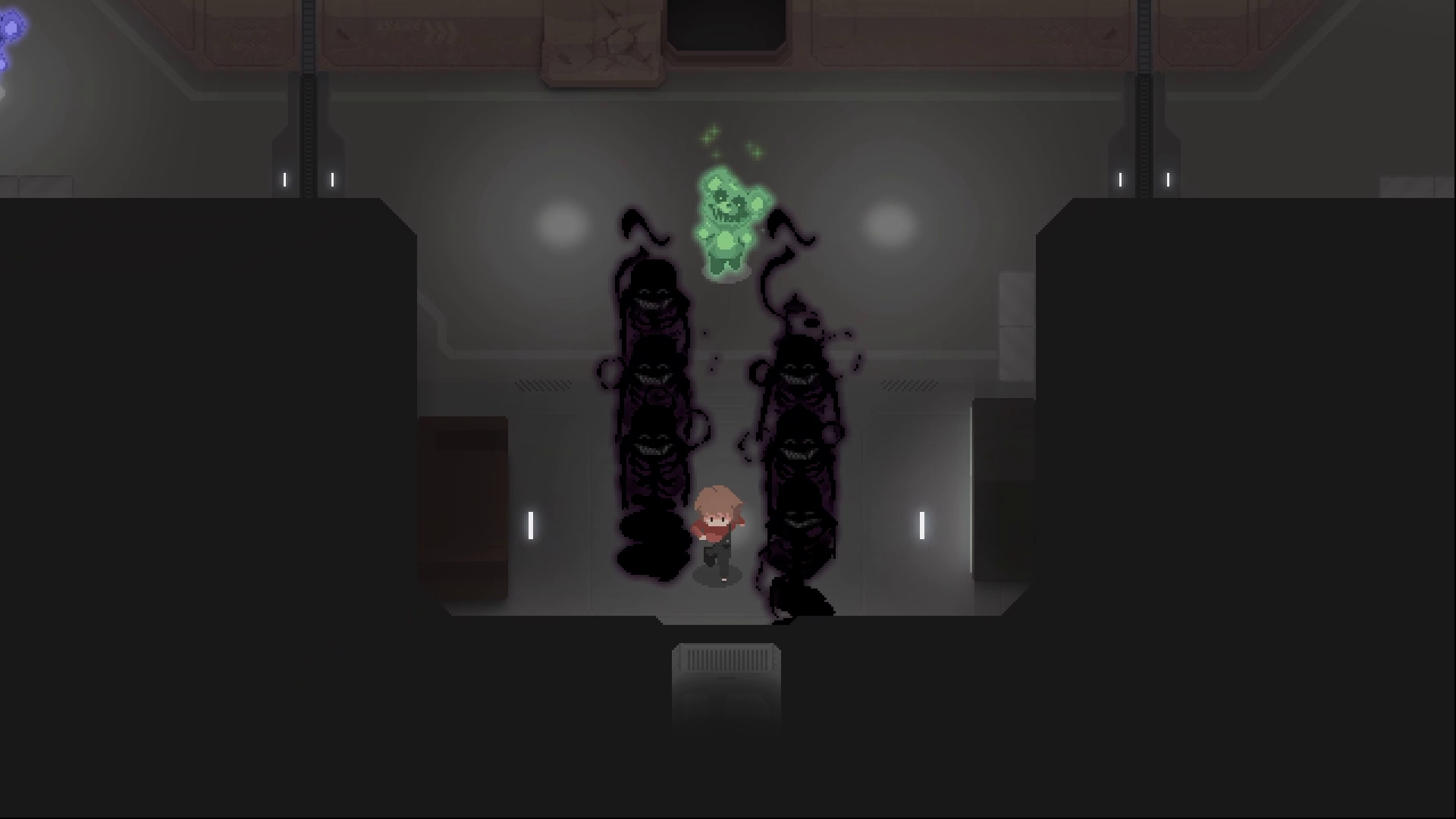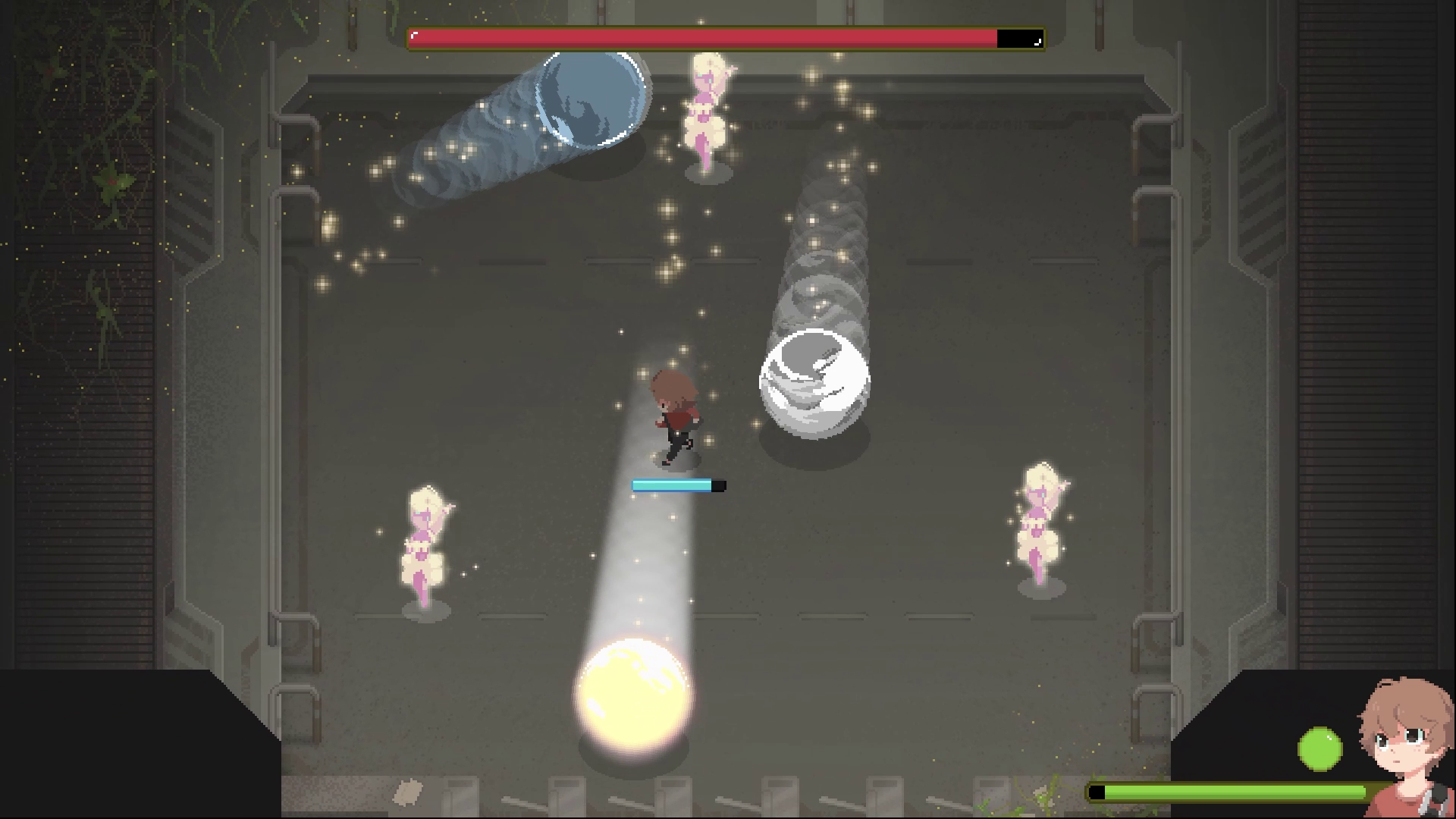
Bittersweet Birthday drops you into mystery from the very first frame: you wake up in a sterile facility with no memory and only a chipper, cryptic voice named Ada on the intercom to guide you. From there the game unfolds as a striking hybrid, a boss‑rush action adventure built around uncompromising one‑on‑one confrontations, stitched to exploration, collectible oddities, and a quietly emotional narrative. Its confrontations demand rhythm and mastery, but the surrounding village, hand‑drawn pixel backdrops, and well‑written NPC moments give those fights context and heart, turning each victory into a piece of a larger, unsettling puzzle about memory, identity, and what it costs to move forward.
Combat - demanding, precise, and always personal
• All boss, all the time: Every encounter plays like a multi‑phase duel rather than a standard skirmish. Enemies arrive with unique rhythms, telegraphed windows, and evolving patterns that reward careful observation and muscle memory.
• Mechanics that demand mastery: Dodges and parries hinge on tight timing; a perfectly timed defense restores stamina and opens opportunities; a mistimed one merely avoids damage and wastes momentum. Heavy strikes create short vulnerability windows, and well‑timed knockdowns buy a burst of free damage that can turn the tide.
• Stamina shapes every choice: Stamina isn’t just a meter, it’s the matchmaker between offense and defense. It controls how long you can press an attack, how often you can evade, and when you must retreat to reset, turning each fight into a focused resource puzzle.
• High skill ceiling, high reward: The combat rewards patience, pattern recognition, and incremental learning. Players who enjoy Souls‑adjacent precision or bullet‑hell timing will find deeply satisfying encounters; those who want a more forgiving, story‑first experience may struggle without persistence or practice.

Between fights - a village of warmth and oddities
• A warm, lived‑in hub: The game offsets the facility’s clinical cold with a vivid village packed with shops, cozy interiors, and incidental details that make the space feel inhabited and worth returning to.
• Conversation drives the pacing: The village is largely dialogue‑forward; NPCs have distinct voices, layered motivations, and interlocking sidequests that gradually reveal worldbuilding and character through small, human moments.
• Meaningful downtime: Light activities; a darts minigame, collectible gachapon, exchangeable trinkets, and other small diversions; provide emotional and mechanical breather points between intense boss encounters.
• Discovery through routine: Exploring homes, reading notes, and following local requests often unlocks memories or items that change combat or open new narrative beats, making mundane interactions feel consequential.
• Charm with occasional friction: The hub’s charm is strong, but navigation and unmarked important NPCs can make tracking sidequests fiddly; persistence is rewarded, but clearer signposting would smooth the experience.

Memories system - build your loadout with risk and reward
• Modular modifiers with personality: Memories function as equipable modifiers that reshape combat and exploration. Positive memories provide tangible boons (reduced damage, passive healing, buffed attacks), while negative memories impose drawbacks but expand your orb capacity, letting you slot more positives for potent synergies.
• Tactical layering: Equipping memories becomes a form of buildcraft; mix defensive perks with high‑risk negatives to create glass‑cannon or endurance‑focused setups, or keep things conservative for steadier, predictable runs.
• Meaningful tradeoffs: Every memory choice forces a real decision: take on a handicap to unlock stronger cumulative benefits, or opt for safety and accept slower, less flashy progress.
• Pre‑fight commitment: Loadouts are locked once a battle starts, so planning matters. The system rewards foresight, experimentation, and learning enemy patterns to exploit your chosen memory combo.
• Design that encourages replay: Because memories dramatically change how encounters feel, they extend replayability by turning the same fights into fresh puzzles when you swap modifiers.

Presentation - pixel charm that sells the tone
• Hand‑drawn pixel art with cinematic depth: Meticulously crafted sprites sit in richly detailed backgrounds that read like layered dioramas; small visual flourishes (lighting, particle snow, subtle parallax) turn static frames into emotionally resonant spaces.
• Audio that shapes mood: A restrained, memorable score and layered ambient design (distant chatter, creaking boards, low mechanical hums) give scenes texture and amplify shifts between warmth and unease.
• Writing that pulls tone taut: Dialogue mixes dry, characterful humor with unsettling mystery, so even long narrative stretches carry emotional weight and occasional menace rather than drifting into filler.
• Visuals and sound working as a pair: Music cues, environmental sound, and expression animation sync to make reveals land harder and quiet moments feel lived‑in, reinforcing the game’s themes of memory, loss, and small comforts.

Friction and pacing issues
• Stuttering pacing between story and combat: Long narrative stretches repeatedly funnel into demanding, multi‑phase boss encounters. In the second half this becomes a stop‑start rhythm where extended blocks of dialogue feel like checkpoints you must slog through to reach the next fight. The enforced pauses between lines amplify the slowdown, so even players who skip text experience jolting tempo shifts.
• Fuzzy navigation and quest tracking: Key NPCs and quest triggers are not clearly signposted, which turns what should be light, character‑driven exploration into tedious backtracking. Players who want to complete side content without exhaustive house‑to‑house checks will find the lack of reliable markers annoying and time‑consuming.
• Difficulty accessibility and player choice: There’s no easy or assist mode and few straightforward options to soften combat for story‑first players. That uncompromising stance sharpens the game’s identity, but it also risks excluding players who prioritize narrative flow or who struggle with fast‑timing mechanics.
• Dialogue flow and readability: The frequent short pauses inserted between lines make long exchanges feel sluggish when you’re trying to progress. A faster text cadence, skippable lines, or smarter auto‑advance options would let players control pacing without losing tone.

Suggested fixes that would help
• Add optional difficulty/assist settings or a “narrative mode” that eases timing windows and stamina demands.
• Implement quest markers or a simple journal that highlights active objectives and important NPCs.
• Give dialogue a faster auto‑advance option, hold‑to‑skip, or improved batching so long conversations don’t break momentum.
• Provide minor QoL tweaks like search/filter for NPCs, better map signposting, and quicker reloads between fights to reduce downtime.
• Net effect: These changes wouldn’t alter the game’s core design but would smooth friction points that currently interrupt immersion and make the second half feel uneven for many players.

Who it’s for
• Play if you love high‑intensity, skill‑driven boss fights wrapped in a strong narrative and evocative setting.
• Skip or wait for patches if you prefer steady pacing, lower difficulty, or more guidance through exploration.

Final Verdict
Bittersweet Birthday is a daring, sometimes messy collision of punishing boss design and tender worldbuilding. Its multi‑phase duels are rigorously crafted and emotionally charged, while the village, characters, and writing lend the fights genuine context and heartbreaking payoff. When combat and story align the result is electrifying, a game that lingers, but mismatches in pacing and an uncompromising difficulty curve can turn momentum into friction and dilute the emotional highs.
For players who love mastering intense one‑on‑one battles and savoring slow‑burn mysteries, Bittersweet Birthday is a standout experience that rewards patience and practice. For those who put narrative flow and accessibility first, try the demo or hold off until difficulty options and QoL patches arrive.
Watch and Wishlist
• Why wishlist: Intense, handcrafted boss encounters and a story‑forward village mean updates (difficulty tweaks, QoL, new content) materially change the experience; wishlisting ensures you get notified about demos, patches, and sales.
• Who should watch: Fans of precision, Souls‑adjacent combat; players who enjoy slow‑burn mysteries and strong character writing; streamers who like dramatic boss fights and memorable set‑pieces.
• What to expect from updates: Balance passes to ease or rebalance encounters, quality‑of‑life fixes (dialogue pacing, quest markers, inventory polish), and occasional content drops or seasonal events.
• Best times to buy: Post‑patch windows and major sales, when difficulty tuning and QoL fixes land, or on launch if you want to support the studio and don’t mind the learning curve.
• Platforms to track: PC (Steam demo and full release); console ports (watch for PlayStation, Xbox, and Switch announcements).
• How to stay informed: Wishlist on Steam, follow the developer/publisher on social media and Discord, and watch for devstreams and patch notes to time your purchase.
• Quick verdict for wishlisters: Wishlist Bittersweet Birthday to catch demos and post‑launch patches; buy after a balancing update if you prefer a smoother narrative experience.
Key Takeaways
• High‑tension boss focus: Every encounter is a multi‑phase duel that rewards pattern recognition, timing, and stamina management.
• Emotionally driven context: A colorful, character‑rich village and strong writing give fights narrative weight and memorable moments.
• Distinct combat systems: Dodges, parries, heavy strikes, and the Memories modifiers combine into meaningful mechanical choices and build variety.
• Presentation punches above its weight: Hand‑drawn pixel art, layered backgrounds, and an evocative soundscape create a striking, lived‑in atmosphere.
• Pacing and flow issues: Long narrative blocks frequently sit between demanding fights; dialogue cadence and enforced pauses can slow momentum.
• Guidance and UX friction: Unmarked NPCs, limited quest tracking, and missing QoL features make side‑content fiddly and exploration less smooth.
• Accessibility concerns: No easy mode or blunt assists mean the game’s steep difficulty can lock out players who prioritize story over reflex skill.
• Worth watching or wishlisting: A compelling, high‑risk experience for players who love punishing one‑on‑one encounters; consider the demo or wait for balance/QoL patches if you prefer a gentler pace.
Game Information:
Developer: World Eater Games
Publisher: DANGEN Entertainment
Platforms: PC - Steam (reviewed)
Release Date: November 11, 2025
Score: 8.0 / 10
Bittersweet Birthday pairs razor‑sharp, multi‑phase boss encounters with a warm, character‑driven hub and an emotionally resonant story. Tight, demanding combat delivers genuine highs, and the village moments give those highs meaning. Occasional pacing hiccups, accessibility limits, and minor UX friction prevent perfection, but the game’s ambition and emotional payoff make it a strong, recommendable experience.